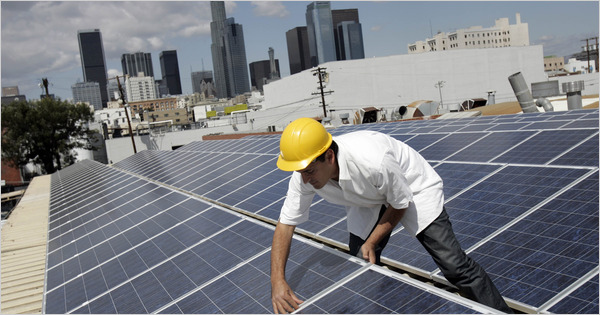Los Angeles Electric Rate Linked to Solar Power

Ann Johansson for The New York Times
Daniel Nazarian, of American Solar Energy Solutions, with a new installation in Los Angeles.
By JENNIFER STEINHAUER
Published: March 10, 2010
LOS ANGELES — Los Angeles averages more than 300 days of sunshine a year, and it often seems as if environmentalists outnumber rattlesnakes in many parts of the sprawling city. It would seem, then, that solar energy would be a thriving local industry here.
But that has never been the case, and experts cite cost as the main reason.
Now, the Los Angeles Department of Water and Power, the largest municipal utility in the United States, is poised to pass a roughly 5 percent rate increase on electricity use. The proceeds would be earmarked for renewable energy purchases and programs, including one that would repay people or businesses that use solar panels to contribute to the power grid.
The commission that governs the utility, which is losing about $6 million a week or an estimated $500 million by the end of the 2011 fiscal year, is expected to vote next week to increase by seven-tenths of 1 cent the current user rate of 12 cents per kilowatt hour. Some proceeds from the increase — which is subject to a City Council vote if the Council chooses to do so, which would not be unlikely — would be used to shore up the budget shortfall, in the hope of protecting the utility’s bond rating.
The rest would go to renewable energy sources, like wind farms, and to help subsidize a program that would essentially repay solar-panel users for feeding energy into the power grid.
City officials say the rate increase — a variation on what some power companies and cities around the country have done to help pay for renewable energy investments — is equivalent to a carbon tax because all consumers will see rates fall as the city becomes less reliant on coal-powered energy.
Tax increases are a political third rail right now in California, where unemployment remains high, wages flat and the economy still sluggish. But Mayor Antonio R. Villaraigosa and his staff are billing the increase as a move that will bring jobs to the city. Los Angeles has never embraced the idea of solar energy, largely because of the high cost of the programs. There are so few solar panel manufacturing companies in the city, mayoral aides have had to scramble to find an appropriate place to announce the new plan later this week.
“A well-crafted carbon surcharge achieves two goals,” Los Angeles’s chief deputy mayor, Jay Carson, said. “The first is a drastic reduction in fossil fuel usage for energy, but the second, and more important for Los Angeles, is the creation of thousands of green-collar jobs.”
Under the proposed program, Los Angeles would take a big step toward Gov. Arnold Schwarzeneggar’s larger goal of one million solar roofs in California by 2018, through state incentive programs. Between $150 million and $160 million per year of the new tax proceeds would be put aside to invest in coal-alternatives for energy use in the city, one of the few that operates under a municipal rather than an investor-owned utility.
The money would also be used to help pay for what is known as a feed-in tariff, under which the utility will pay a set rate for electricity from customers who install solar panels.
European countries have had mixed results — some wildly successful, some a horrific bust — with feed-in tariffs.
The city would also offer more incentives to users who get solar panels from panel makers in Los Angeles — a practice known as local preference — which Mr. Carson said would give such companies incentive to open up shop here.
The city would adopt an increasingly popular program in which homes undergo an energy audit and their owners borrow money from the government to make them more efficient.
“This is essentially Ladwp coming out of the stone age,” said Severin Borenstein, a co-director of the Energy Institute at the Haas School of Business at the University of California, referring to the power agency.
Professor Borenstein gave the proposed tax increase a mixed review. “Some of the changes make sense,” he said, citing long-term contracts for renewable energy that reduce the carbon in the city’s energy mix. Mr. Carson said this would result in decreases in the overall electric bill consumers pay, thus the “carbon tax” moniker.
But “feed-in tariffs for solar power is not good use of money,” Professor Borenstein said. “Solar power at the residential level is not close to economical. There are many things you should do before you subsidize it.”
Californians have been squeezed by high unemployment and fee increases, and Los Angelenos may not cotton easily to a rate increase.
“Californians are environmentally conscious,” said Dan Schnur, the director of the Jesse M. Unruh Institute of Politics at the University of Southern California. “But much less so if it causes them economic difficulty.”
